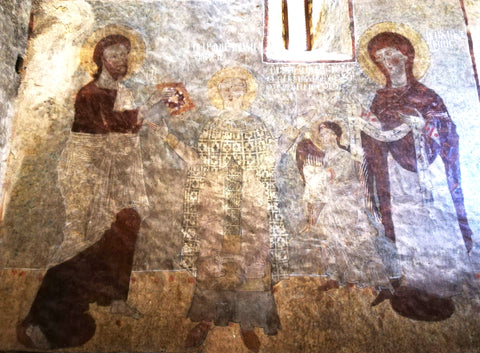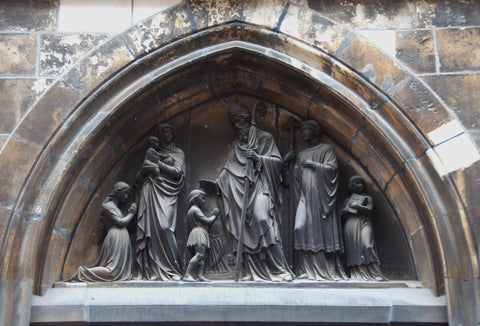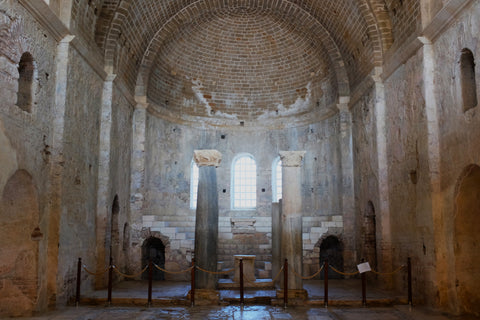The feast of Sinterklaas
by Jona Lendering
In the evening of 5 December – or the morning after for those not yet initiated in the ‘big secret’ – the Dutch celebrate the feast of Sinterklaas (St. Nicholas). On pakjesavond ("presents evening”), families, and friends gather together and exchange gifts while enjoying typical Dutch treats such as ‘pepernoten’, ‘taaitaai’, chocolate coins, and chocolate bars in the shape of a letter. Even more fun are the prank gifts, often accompanied by poems from the ‘Sint’ or one of his helpers, all named Piet (‘Pete’).
So who exactly is this St. Nicholas?
Bishop of Myra
We don’t know much about the earthly existence of St. Nicholas, although several parts of his saintly life correspond to what we know of the life and work of fourth-century bishops, and there is reason to believe that he may have lived during the reign of Constantine the Great (r.306–337).
There is no contemporary biography on St. Nicolas, and if there were ever collections of Nicholas’ pastoral epistles or theological treatises, these are now lost. The first hagiography of the bishop of Myra, written by an otherwise unknown Michael the Archimandrite, dates to ca. 700.

In his Life, Works, and Miracles of our Holy Father Nicholas, Archbishop of Myra in Lycia, Michael tells us that Nicholas was born in Patara in Turkey (§3) and lived an exemplary life (§8). As an infant, for example, he had already shown his holiness by refusing his mother's breast on Friday, the day on which Christ had been crucified (§5). So far, these are standard motifs.
Nicholas' parents died when he was still young, and he started to give away everything he inherited (§9). In §§10-17, for example, we read a famous story about an impoverished man who is unable to offer a dowry to potential suitors for his three daughters, and “ordered them to work in a brothel, so that he and the family would have some income." Fortunately, Nicholas intervenes, and throws a purse filled with gold coins through one of the windows of the house of the poor people. This is a motif from Anatolian folklore, also known from Philostratus’ Life of Apollonius.

Liberated of his worldly possessions, Nicholas then became bishop of Myra, a little port in the southwest of Turkey, where he distinguished himself through many good deeds. For example, there is a story of three generals, who have, although innocent, been jailed. They are released when the saint appears to the responsible officials in Constantinople. This story is clearly fictional. We’re supposed to believe that the saint was seen in his study in Myra at the same time. However, we know that during the reign of Constantine, bishops did in fact intervene in legal proceedings. The story may not be accurate in its present form, but may still contain a nucleus of truth.
The death of St. Nicholas
After a famine had miraculously ended (§§37-39), the venerable saint drew his last breath on December 6 in an unknown year. His remains were buried in a church outside the city walls, but this was not the only place of Christian worship in Myra.

In the 1990s, Russian archaeologists identified the remains of another church located in Andriake, the quarter along the harbor. Its foundations were laid after AD 311, when Christianity was recognized as religio licita, and before AD 337, when it was no longer necessary to build churches in the suburbs.
The excavators of this church have argued that Nicholas must have been the builder, which would explain the many sailors Nicholas is said to have saved during his lifetime, as mentioned by Michael the Archimandrite (§§34-36 and §§45-48). Again, here is a possibility of a nucleus of Roman truth in a medieval legend.
The remains from Nicholas’ tomb were brought to Bari (Italy) in 1087, where they have been venerated ever since. Some of the saint’s bones, however, were brought to Venice and Lyons, while others are said to reside in a box in a museum in Antalya.

Patron of sailors
St. Nicholas was quite a busy man after his lifetime, as he is regarded as the patron of the children, sailors, fishermen, coopers, butchers, newlyweds, students, merchants, bankers, thieves, prostitutes, officers, hoteliers, prisoners, unmarried women with the desire to find a partner, many port cities, Russia and Greece, all the cities and villages in the world that call “St. Nicholas” or something similar, anyone with a name derived from ‘Nicholas’ and more specifically of all mankind.
Nicholas is said to have died on December 6, the same day as Saint Cassian. During their ascent, Nicholas heard the anguished cries and prayers of some sailors in distress. The patron of the seafarers needed no time to think it over and dove into the sea, saved a sailor from drowning, calmed the storm, and guided the ship to a safe haven. Only when he had determined that everyone was safe, did he continue his ascension.
![]()
At the gates of Heaven, Saint Peter asked Nicholas why he had arrived late – and wet. Nicholas recounted his tale, and Peter asked Cassian if he had not heard the cries for help? Yes, replied Cassian, but he had been too focused on God's majesty to pay much attention to it.
Peter, impressed by Nicholas’ efforts, decided that from now on he would have four feast days: his birthday, his death day, the day on which the Basilica of St. Nicholas in Constantinople was consecrated, and the day on which his relics were transferred from Myra to Bari.
Sinterklaas in the Netherlands
The anticipation of the feast of Sinterklaas in the Netherlands starts in November, when the saint arrives by steamboat at a port of that year’s choosing, after a (supposed) long voyage from Spain (which corresponds to the fact that the saint’s remains lie in Bari, which for centuries was part of the Spanish dominions).
After the saint’s arrival, children can place their shoe by the hearth (or elsewhere in case of a lacking fireplace), and place a carrot in their shoe for the saint’s horse. They can only hope that Pete will pass by their door, and place a present in their shoe. The evening of December 5 is when it really counts though, and children sing Sinterklaas songs at the top of their lungs. Those who are not on the ‘naughty list’, will wake up to shoes filled with gifts the following morning.
All in all, the historical truth of Sinterklaas is of course not very important. It is all about the values he transfers, and during Sinterklaas, we reflect on the joy of giving without expecting anything in return. This is why, although the saint gives presents to children, it is essentially something for grown-up people.
